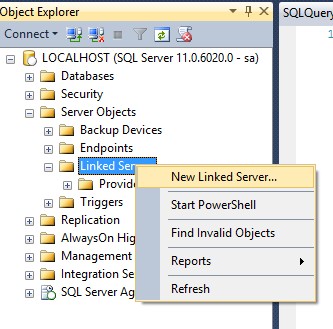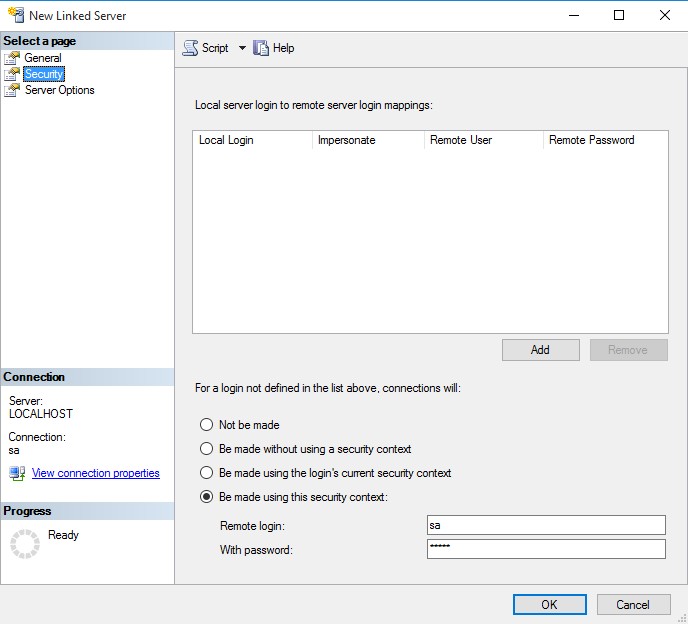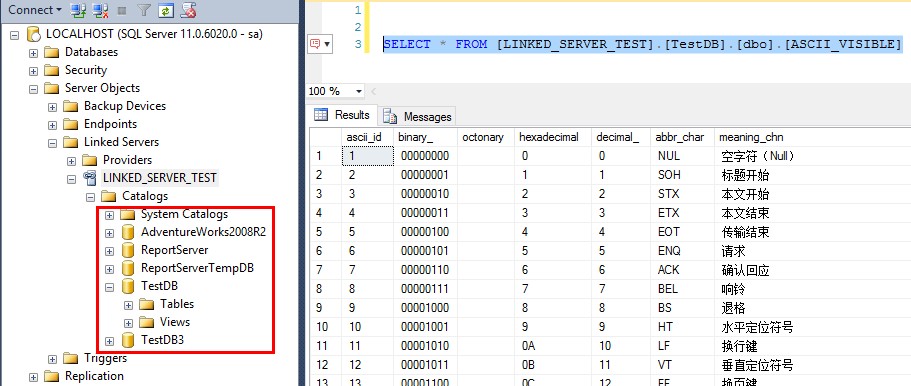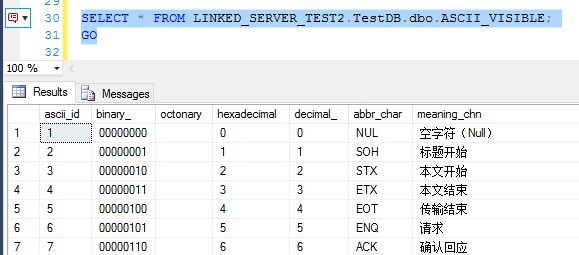SQLServer提供了多種數據導出導入的工具和方法,在此,分享我實踐的經驗(只涉及資料庫與Excel、資料庫與文本文件、資料庫與資料庫之間的導出導入)。(一)資料庫與Excel方法1:使用資料庫客戶端(SSMS)的界面工具。右鍵選擇要導出數據的資料庫,選擇“任務”——“導出數據”,下圖1,按照嚮導...
SQLServer提供了多種數據導出導入的工具和方法,在此,分享我實踐的經驗(只涉及資料庫與Excel、資料庫與文本文件、資料庫與資料庫之間的導出導入)。
(一)資料庫與Excel
方法1:
使用資料庫客戶端(SSMS)的界面工具。右鍵選擇要導出數據的資料庫,選擇“任務”——“導出數據”,下圖1,按照嚮導一步一步操作即可。而導入則相反,導入時,SQLServer會預設創建一張新表,欄位名也預設跟導入的Excel標題一樣,並且會預設欄位數據類型等。當然在可以在嚮導進行修改。需要註意的是如果標題不是英文而是中文,預設創建欄位名也是中文,這將給後面數據更新操作帶來麻煩,所以最好還是以有意義的英文欄位名。把數據導入後,再通過執行語句,把數據插入/更新到業務表。

figure-1:任務——導出數據
方法2:
從SQLServer2005開始,可以直接在SSMS上查詢出來的結果複製,然後粘貼到Excel上,對於少量數據來說,是非常快速方便的,需要註意的是長數字可能會變成科學記數法的形式,提前在Excel上指定列的格式為文本即可。
導入的話,ctrl + c 複製Excel上的數據,然後在選擇相關表,編輯數據,把數據直接粘貼上去即可。但是不建議直接粘貼到業務表(如果表是空白沒有數據,並且欄位順序對應,可以這樣操作),而是建議先粘貼到一個新建的中間表中,然後再通過語句,把數據插入/更新到業務表。
這種方法的導出導入,適合於少量的數據,如5000行以內的記錄,大於5000行以上就不建議了,速度較慢,如果數據過大,還一定成功。
(二)資料庫與文本文件、資料庫與資料庫
資料庫之間的數據遷移或導出導入其實是比較方便的,比如備份資料庫後,在新的機器上做恢復。但是需要註意的是SQL2008之前的版本的備份無法在SQL2012或以上版本上直接恢復的,而是通過中間的SQL2008做一個過渡,把舊版本的資料庫恢復到SQL2008,然後做備份,最後在SQL2012上恢復。
如果是新版本(下麵以SQL2012為例)的備份文件恢復到舊版本(以SQL2008為例)上就比較麻煩了,一般是不支持新版本備份文件在舊版本中恢復的。只能通過編寫腳本,把新版本的數據導入到舊版本中。
方法1:
首先推薦使用的是數據不落地的“鏈接伺服器”。使用SQL2012的SSMS,同時連接到SQL2012和SQL2008的實例,通過編寫腳本把SQL2012的數據導入到SQL2008中。兩個實例的可以通過鏈接伺服器來連接。以下是設置步驟。

figure-2:新建鏈接伺服器

figure-3:鏈接伺服器和數據源

figure-4:認證

figure-5:創建成功後,可以直接瀏覽鏈接伺服器的目錄,也可以使用語句查詢了。
也可以使用腳本來創建鏈接伺服器。
--創建鏈接伺服器 EXEC sp_addlinkedserver @server='LINKED_SERVER_TEST2',--被訪問的伺服器別名 @srvproduct='', @provider='SQLOLEDB', @datasrc='192.168.88.6,11433'--數據源 GO --創建登錄名和密碼 EXEC sys.sp_addlinkedsrvlogin @rmtsrvname = 'LINKED_SERVER_TEST2', -- 被訪問的伺服器別名 @useself = 'false', @locallogin = NULL, @rmtuser = 'sa', -- 數據源登錄名 @rmtpassword = 'psd123456' -- 數據源登錄密碼 GO --設置數據可以訪問 EXEC sys.sp_serveroption @server = 'LINKED_SERVER_TEST2', @optname = 'data access', @optvalue = N'true' GO
code-1:創建鏈接伺服器的腳本
創建成功後,可以直接查詢數據。

figure-6:查詢鏈接伺服器的數據
通過視圖sys.servers可以查詢所有伺服器及相關的屬性。

figure-7:查詢所有鏈接伺服器
在SSMS上或運行以下腳本可以刪除指定的鏈接伺服器。
--刪除鏈接伺服器及所有登錄 EXEC sys.sp_dropserver @server = 'LINKED_SERVER_TEST2', @droplogins = 'droplogins' GO
code-2:刪除鏈接伺服器及所有登錄
詳細請參考:https://technet.microsoft.com/zh-cn/library/ff772782%28v=sql.105%29.aspx
方法2:
如果兩個實例不能連接,只能在SQL2012上導出數據,再到SQL2008上導入。SQLServer提供生成包含數據的腳本工具,下圖2。在第三步的“高級”選項里有一項“Types of data to scripts”有三個選擇:Data only,Schema and data,Schema only,分別是只生成數據、生成表(對象)和數據,表(對象)。還有生成腳本的版本“Script for Server Version”,下圖3。其他選項,按實際需要選擇。

figure-8:任務——生成腳本

figure-9:生成腳本的高級選項
也可以使用存儲過程生成包含數據的腳本。這裡介紹一個別人已經做寫好存儲過程:sp_generate_inserts。運行之後,會按表每條記錄生成一條insert的語句

CREATE PROC [dbo].[sp_generate_inserts] ( @table_name VARCHAR(776) , -- The table/view for which the INSERT statements will be generated using the existing data @target_table VARCHAR(776) = NULL , -- Use this parameter to specify a different table name into which the data will be inserted @include_column_list BIT = 1 , -- Use this parameter to include/ommit column list in the generated INSERT statement @from VARCHAR(800) = NULL , -- Use this parameter to filter the rows based on a filter condition (using WHERE) @include_timestamp BIT = 0 , -- Specify 1 for this parameter, if you want to include the TIMESTAMP/ROWVERSION column's data in the INSERT statement @debug_mode BIT = 0 , -- If @debug_mode is set to 1, the SQL statements constructed by this procedure will be printed for later examination @owner VARCHAR(64) = NULL , -- Use this parameter if you are not the owner of the table @ommit_images BIT = 0 , -- Use this parameter to generate INSERT statements by omitting the 'image' columns @ommit_identity BIT = 1 , -- Use this parameter to ommit the identity columns @top INT = NULL , -- Use this parameter to generate INSERT statements only for the TOP n rows @cols_to_include VARCHAR(8000) = NULL , -- List of columns to be included in the INSERT statement @cols_to_exclude VARCHAR(8000) = NULL , -- List of columns to be excluded from the INSERT statement @disable_constraints BIT = 0 , -- When 1, disables foreign key constraints and enables them after the INSERT statements @ommit_computed_cols BIT = 1 -- When 1, computed columns will not be included in the INSERT statement ) AS BEGIN /*********************************************************************************************************** Procedure: sp_generate_inserts (Build 22) (Copyright ?2002 Narayana Vyas Kondreddi. All rights reserved.) Purpose: To generate INSERT statements from existing data. These INSERTS can be executed to regenerate the data at some other location. This procedure is also useful to create a database setup, where in you can script your data along with your table definitions. Written by: Narayana Vyas Kondreddi http://vyaskn.tripod.com Acknowledgements: Divya Kalra -- For beta testing Mark Charsley -- For reporting a problem with scripting uniqueidentifier columns with NULL values Artur Zeygman -- For helping me simplify a bit of code for handling non-dbo owned tables Joris Laperre -- For reporting a regression bug in handling text/ntext columns Tested on: SQL Server 7.0 and SQL Server 2000 Date created: January 17th 2001 21:52 GMT Date modified: May 1st 2002 19:50 GMT Email: [email protected] NOTE: This procedure may not work with tables with too many columns. Results can be unpredictable with huge text columns or SQL Server 2000's sql_variant data types Whenever possible, Use @include_column_list parameter to ommit column list in the INSERT statement, for better results IMPORTANT: This procedure is not tested with internation data (Extended characters or Unicode). If needed you might want to convert the datatypes of character variables in this procedure to their respective unicode counterparts like nchar and nvarchar Example 1: To generate INSERT statements for table 'titles': EXEC sp_generate_inserts 'titles' Example 2: To ommit the column list in the INSERT statement: (Column list is included by default) IMPORTANT: If you have too many columns, you are advised to ommit column list, as shown below, to avoid erroneous results EXEC sp_generate_inserts 'titles', @include_column_list = 0 Example 3: To generate INSERT statements for 'titlesCopy' table from 'titles' table: EXEC sp_generate_inserts 'titles', 'titlesCopy' Example 4: To generate INSERT statements for 'titles' table for only those titles which contain the word 'Computer' in them: NOTE: Do not complicate the FROM or WHERE clause here. It's assumed that you are good with T-SQL if you are using this parameter EXEC sp_generate_inserts 'titles', @from = "from titles where title like '%Computer%'" Example 5: To specify that you want to include TIMESTAMP column's data as well in the INSERT statement: (By default TIMESTAMP column's data is not scripted) EXEC sp_generate_inserts 'titles', @include_timestamp = 1 Example 6: To print the debug information: EXEC sp_generate_inserts 'titles', @debug_mode = 1 Example 7: If you are not the owner of the table, use @owner parameter to specify the owner name To use this option, you must have SELECT permissions on that table EXEC sp_generate_inserts Nickstable, @owner = 'Nick' Example 8: To generate INSERT statements for the rest of the columns excluding images When using this otion, DO NOT set @include_column_list parameter to 0. EXEC sp_generate_inserts imgtable, @ommit_images = 1 Example 9: To generate INSERT statements excluding (ommiting) IDENTITY columns: (By default IDENTITY columns are included in the INSERT statement) EXEC sp_generate_inserts mytable, @ommit_identity = 1 Example 10: To generate INSERT statements for the TOP 10 rows in the table: EXEC sp_generate_inserts mytable, @top = 10 Example 11: To generate INSERT statements with only those columns you want: EXEC sp_generate_inserts titles, @cols_to_include = "'title','title_id','au_id'" Example 12: To generate INSERT statements by omitting certain columns: EXEC sp_generate_inserts titles, @cols_to_exclude = "'title','title_id','au_id'" Example 13: To avoid checking the foreign key constraints while loading data with INSERT statements: EXEC sp_generate_inserts titles, @disable_constraints = 1 Example 14: To exclude computed columns from the INSERT statement: EXEC sp_generate_inserts MyTable, @ommit_computed_cols = 1 ***********************************************************************************************************/ SET NOCOUNT ON --Making sure user only uses either @cols_to_include or @cols_to_exclude IF ( ( @cols_to_include IS NOT NULL ) AND ( @cols_to_exclude IS NOT NULL ) ) BEGIN RAISERROR('Use either @cols_to_include or @cols_to_exclude. Do not use both the parameters at once',16,1) RETURN -1 --Failure. Reason: Both @cols_to_include and @cols_to_exclude parameters are specified END --Making sure the @cols_to_include and @cols_to_exclude parameters are receiving values in proper format IF ( ( @cols_to_include IS NOT NULL ) AND ( PATINDEX('''%''', @cols_to_include) = 0 ) ) BEGIN RAISERROR('Invalid use of @cols_to_include property',16,1) PRINT 'Specify column names surrounded by single quotes and separated by commas' PRINT 'Eg: EXEC sp_generate_inserts titles, @cols_to_include = "''title_id'',''title''"' RETURN -1 --Failure. Reason: Invalid use of @cols_to_include property END IF ( ( @cols_to_exclude IS NOT NULL ) AND ( PATINDEX('''%''', @cols_to_exclude) = 0 ) ) BEGIN RAISERROR('Invalid use of @cols_to_exclude property',16,1) PRINT 'Specify column names surrounded by single quotes and separated by commas' PRINT 'Eg: EXEC sp_generate_inserts titles, @cols_to_exclude = "''title_id'',''title''"' RETURN -1 --Failure. Reason: Invalid use of @cols_to_exclude property END --Checking to see if the database name is specified along wih the table name --Your database context should be local to the table for which you want to generate INSERT statements --specifying the database name is not allowed IF ( PARSENAME(@table_name, 3) ) IS NOT NULL BEGIN RAISERROR('Do not specify the database name. Be in the required database and just specify the table name.',16,1) RETURN -1 --Failure. Reason: Database name is specified along with the table name, which is not allowed END --Checking for the existence of 'user table' or 'view' --This procedure is not written to work on system tables --To script the data in system tables, just create a view on the system tables and script the view instead IF @owner IS NULL BEGIN IF ( ( OBJECT_ID(@table_name, 'U') IS NULL ) AND ( OBJECT_ID(@table_name, 'V') IS NULL ) ) BEGIN RAISERROR('User table or view not found.',16,1) PRINT 'You may see this error, if you are not the owner of this table or view. In that case use @owner parameter to specify the owner name.' PRINT 'Make sure you have SELECT permission on that table or view.' RETURN -1 --Failure. Reason: There is no user table or view with this name END END ELSE BEGIN IF NOT EXISTS ( SELECT 1 FROM INFORMATION_SCHEMA.TABLES WHERE TABLE_NAME = @table_name AND ( TABLE_TYPE = 'BASE TABLE' OR TABLE_TYPE = 'VIEW' ) AND TABLE_SCHEMA = @owner ) BEGIN RAISERROR('User table or view not found.',16,1) PRINT 'You may see this error, if you are not the owner of this table. In that case use @owner parameter to specify the owner name.' PRINT 'Make sure you have SELECT permission on that table or view.' RETURN -1 --Failure. Reason: There is no user table or view with this name END END --Variable declarations DECLARE @Column_ID INT , @Column_List NVARCHAR(MAX) , @Column_Name VARCHAR(128) , @Start_Insert NVARCHAR(MAX) , @Data_Type VARCHAR(128) , @Actual_Values NVARCHAR(MAX) , --This is the string that will be finally executed to generate INSERT statements @IDN VARCHAR(128) --Will contain the IDENTITY column's name in the table --Variable Initialization SET @IDN = '' SET @Column_ID = 0 SET @Column_Name = '' SET @Column_List = '' SET @Actual_Values = '' IF @owner IS NULL BEGIN SET @Start_Insert = 'INSERT INTO ' + '[' + RTRIM(COALESCE(@target_table, @table_name)) + ']' END ELSE BEGIN SET @Start_Insert = 'INSERT ' + '[' + LTRIM(RTRIM(@owner)) + '].' + '[' + RTRIM(COALESCE(@target_table, @table_name)) + ']' END --To get the first column's ID SELECT @Column_ID = MIN(ORDINAL_POSITION) FROM INFORMATION_SCHEMA.COLUMNS (NOLOCK) WHERE TABLE_NAME = @table_name AND ( @owner IS NULL OR TABLE_SCHEMA = @owner ) --Loop through all the columns of the table, to get the column names and their data types WHILE @Column_ID IS NOT NULL BEGIN SELECT @Column_Name = QUOTENAME(COLUMN_NAME) , @Data_Type = DATA_TYPE FROM INFORMATION_SCHEMA.COLUMNS (NOLOCK) WHERE ORDINAL_POSITION = @Column_ID AND TABLE_NAME = @table_name AND ( @owner IS NULL OR TABLE_SCHEMA = @owner ) IF @cols_to_include IS NOT NULL --Selecting only user specified columns BEGIN IF CHARINDEX('''' + SUBSTRING(@Column_Name, 2, LEN(@Column_Name) - 2) + '''', @cols_to_include) = 0 BEGIN GOTO SKIP_LOOP END END IF @cols_to_exclude IS NOT NULL --Selecting only user specified columns BEGIN IF CHARINDEX('''' + SUBSTRING(@Column_Name, 2, LEN(@Column_Name) - 2) + '''', @cols_to_exclude) <> 0 BEGIN GOTO SKIP_LOOP END END --Making sure to output SET IDENTITY_INSERT ON/OFF in case the table has an IDENTITY column IF ( SELECT COLUMNPROPERTY(OBJECT_ID(QUOTENAME(COALESCE(@owner, USER_NAME())) + '.' + @table_name), SUBSTRING(@Column_Name, 2, LEN(@Column_Name) - 2), 'IsIdentity') ) = 1 BEGIN IF @ommit_identity = 0 --Determing whether to include or exclude the IDENTITY column SET @IDN = @Column_Name ELSE GOTO SKIP_LOOP END --Making sure whether to output computed columns or not IF @ommit_computed_cols = 1 BEGIN IF ( SELECT COLUMNPROPERTY(OBJECT_ID(QUOTENAME(COALESCE(@owner, USER_NAME())) + '.' + @table_name), SUBSTRING(@Column_Name, 2, LEN(@Column_Name) - 2), 'IsComputed') ) = 1 BEGIN GOTO SKIP_LOOP END END --Tables with columns of IMAGE data type are not supported for obvious reasons IF ( @Data_Type IN ( 'image' ) ) BEGIN IF ( @ommit_images = 0 ) BEGIN RAISERROR('Tables with image columns are not supported.',16,1) PRINT 'Use @ommit_images = 1 parameter to generate INSERTs for the rest of the columns.' PRINT 'DO NOT ommit Column List in the INSERT statements. If you ommit column list using @include_column_list=0, the generated INSERTs will fail.' RETURN -1 --Failure. Reason: There is a column with image data type END ELSE BEGIN GOTO SKIP_LOOP END END --Determining the data type of the column and depending on the data type, the VALUES part of --the INSERT statement is generated. Care is taken to handle columns with NULL values. Also --making sure, not to lose any data from flot, real, money, smallmomey, datetime columns SET @Actual_Values = @Actual_Values + CASE WHEN @Data_Type IN ( 'char', 'varchar', 'nchar','nvarchar' ) THEN 'COALESCE(''N'''''' + REPLACE(RTRIM(' + @Column_Name + '),'''''''','''''''''''')+'''''''',''NULL'')' WHEN @Data_Type IN ( 'datetime', 'smalldatetime', 'DATE','time' ) THEN 'COALESCE('''''''' + RTRIM(CONVERT(char,' + @Column_Name + ',120))+'''''''',''NULL'')' WHEN @Data_Type IN ( 'uniqueidentifier' ) THEN 'COALESCE('''''''' + REPLACE(CONVERT(char(255),RTRIM(' + @Column_Name + ')),'''''''','''''''''''')+'''''''',''NULL'')' WHEN @Data_Type IN ( 'text', 'ntext' ) THEN 'COALESCE(''N'''''' + REPLACE(CONVERT(char(8000),' + @Column_Name + '),'''''''','''''''''''')+'''''''',''NULL'')' WHEN @Data_Type IN ( 'binary', 'varbinary' ) THEN 'COALESCE(RTRIM(CONVERT(char,' + 'CONVERT(int,' + @Column_Name + '))),''NULL'')' WHEN @Data_Type IN ( 'timestamp', 'rowversion' ) THEN CASE WHEN @include_timestamp = 0 THEN '''DEFAULT''' ELSE 'COALESCE(RTRIM(CONVERT(char,' + 'CONVERT(int,' + @Column_Name +




